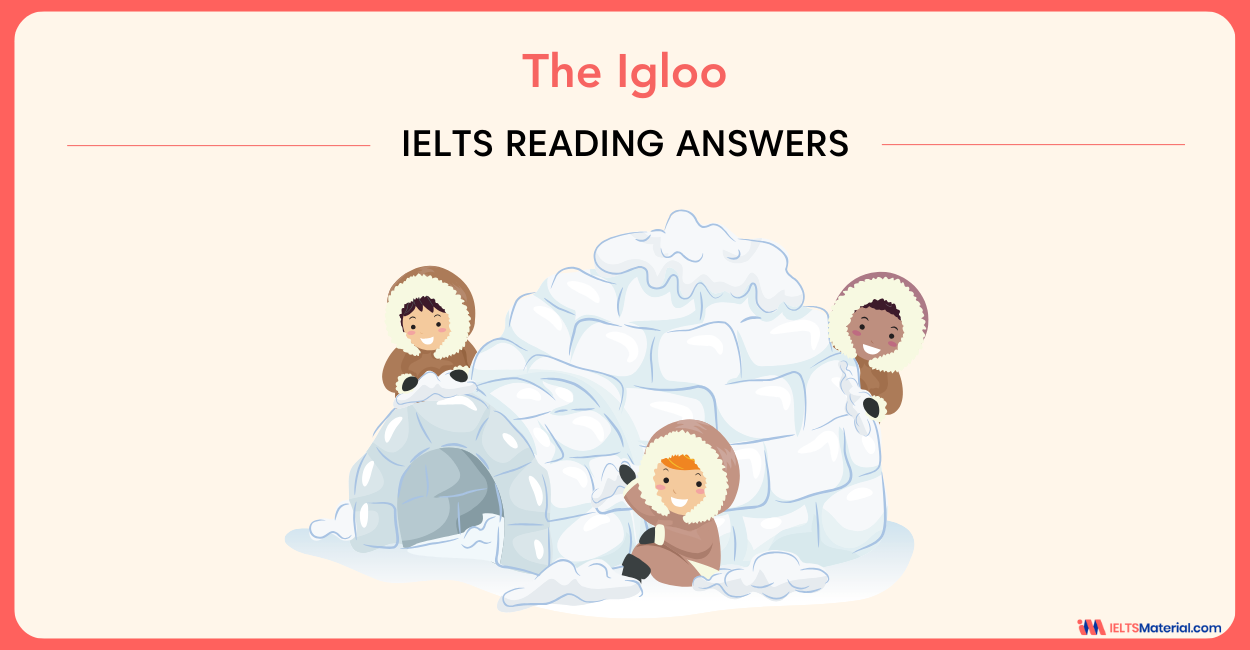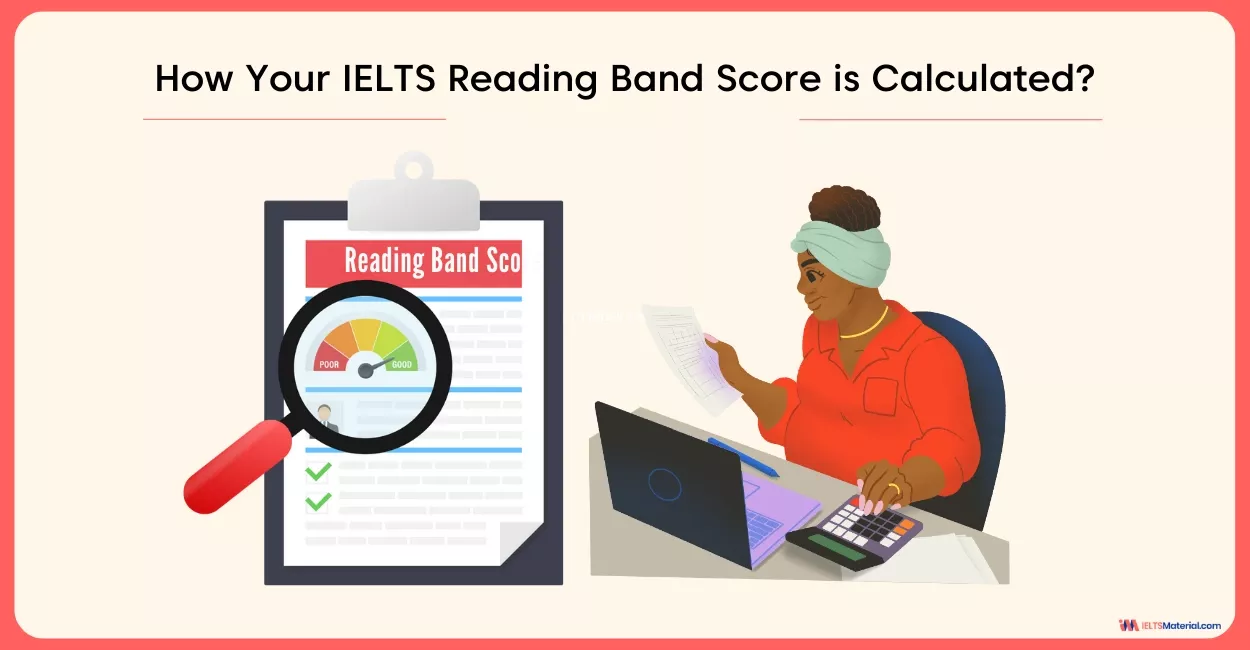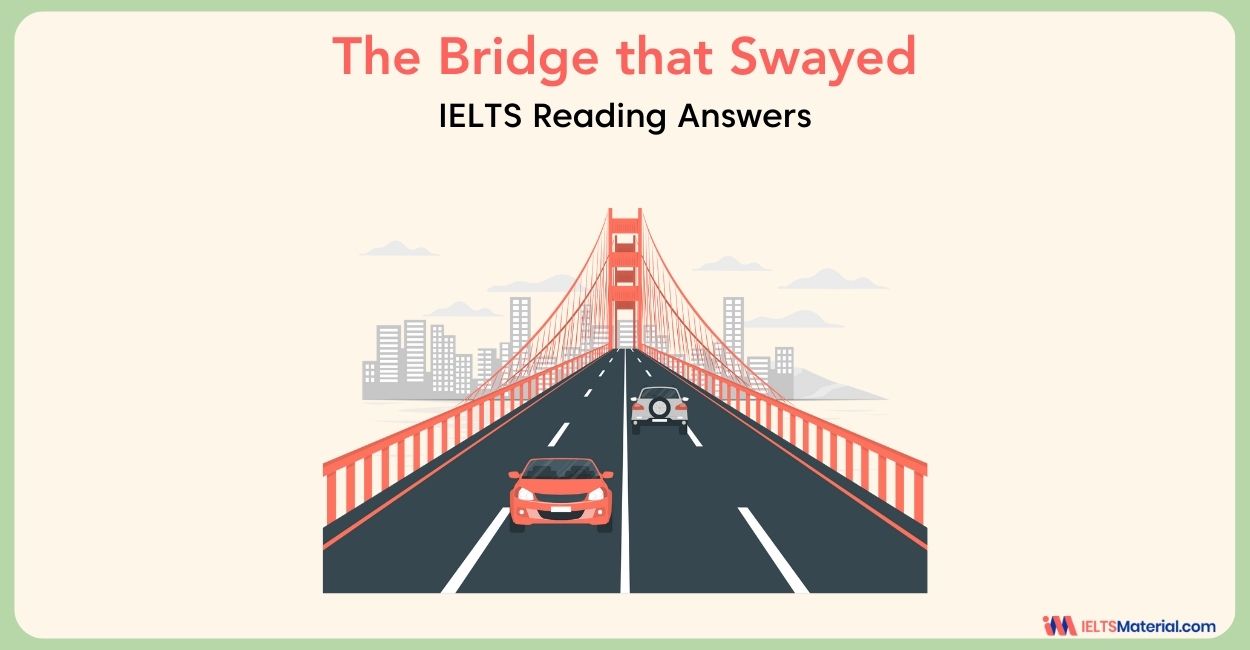The Bridge that Swayed Reading Answers
Want to ace the IELTS Reading test? Explore The Bridge that Swayed IELTS Reading Answers for expert step-by-step answer explanation on tackling tricky questions efficiently. Improve your reading skills, and enhance your score with proven strategies!
Table of Contents
- The Bridge that Swayed IELTS Reading Passage
- The Bridge That Swayed IELTS Reading Questions
- The Bridge that Swayed IELTS Reading Answers With Explanations
- Tips for The Bridge that Swayed IELTS Reading Answers - Multiple Choice Questions (Q.14 – Q.17)
- Tips for The Bridge that Swayed IELTS Reading Answers - Summary Completion (Q.18 – Q.23)
- Tips for The Bridge that Swayed IELTS Reading Answers - Table Completion (Q.24 – Q.26)
- Check More IELTS Reading Answers

Limited-Time Offer : Access a FREE 10-Day IELTS Study Plan!
The IELTS Reading passage, “Bridge that Swayed”, has appeared in the recent IELTS Academic examination. With diligent practice, the Reading Module can be the top-scoring category for IELTS Aspirants. To score well, you must understand how to approach and answer the different question types in the Reading Module. By solving and reviewing Sample Reading Questions from past IELTS papers, you can ensure that your Reading skills are up to the mark. Practice the reading passage ‘The Bridge that Swayed’ below and for more, try IELTS reading practice tests.
- Multiple Choice Questions (Q.14 – Q.17)
- Summary Completion (Q.18 – Q.23)
- Table completion (Q.24 – Q.26)
Before taking the test, refresh your skills by taking a look at IELTS Reading Summary Completion – Lessons and Tips.
The Bridge that Swayed IELTS Reading Passage
Read the whole passage and respond to the questions carefully, and check your responses with our The bridge that swayed reading answers with location. You should spend about 20 minutes on Questions 14-26, which are based on the Reading Passage below.
The Bridge That Swayed
1. When the London Millennium footbridge was opened in June 2000, it swayed alarmingly. This generated huge public interest and the bridge became known as London's "wobbly bridge".
2. The Millennium Bridge is the first new bridge to access the river Thames in London since Tower Bridge opened in 1894, and it is the first ever designed for pedestrians only. The bridge links the City of London near St Paul's Cathedral with the Tate Modern art gallery on Bankside.
3. The bridge opened initially on Saturday 10th June 2000. For the opening ceremony, a crowd of over 1,000 people had assembled on the south half of the bridge with a band in front. When they started to walk across with the band playing, there was immediately an unexpectedly pronounced lateral movement of the bridge deck. "It was a fine day and the bridge was on the route of a major organised walk for a noble cause," one of the pedestrians recounted what he saw that day. “At first, it was still. Then it began to sway sideways, just slightly. Then, almost from one moment to the next, when large groups of people were crossing, the wobble intensified. Everyone had to stop walking to retain balance and sometimes to hold on to the handrails for support”. Immediately, it was decided to limit the number of people on the bridge, and the bridge was dubbed the ‘wobbly’ bridge by the media who declared it another high-profile British Millennium Project failure. In order to fully investigate and resolve the issue the decision was taken to close the bridge on 12th June 2000.
4. Arup, the leading member of the committee in charge of the construction of the bridge, decided to tackle the issue head on. They immediately undertook a fast-track research project to seek the cause and the cure. The embarrassed engineers found the videotape that day which showed the centre span swaying about 3 inches sideways every second and the south span 2 inches every 1.25 seconds. Because there was a significant wind blowing on the opening days (force 3-4) and the bridge had been decorated with large flags, the engineers first thought that winds might the exerting excessive force on the many large flags and banners, but it was rapidly concluded that wind buffering had not contributed significantly to vibration of the bridge. But after measurements were made in university laboratories of the effects of people walking on swaying platforms and after large-scale experiments with crowds of pedestrians were conducted on the bridge itself, a new understanding and a new theory were developed.
5. The unexpected motion was the result of a natural human reaction to small lateral movements. It is well known that a suspension bridge has a tendency to sway when troops march over it in lockstep, which is why troops are required to break step when crossing such a bridge. “If we walk on a swaying surface we tend to compensate and stabilise ourselves by spreading our legs further apart but this increases the lateral push”. Pat Dallard, the engineer at Arup, says that you change the way you walk to match what the bridge is doing. It is an unconscious tendency for pedestrians to match their footsteps to the sway, thereby exacerbating it even more. “It's rather like walking on a rolling ship deck, you move one way and then the other to compensate for the roll.” The way people walk doesn't have to match exactly the natural frequency of the bridge as in resonance the interaction is more subtle. As the bridge moves, people adjust the way they walk in their own manner. The problem is that when there are enough people on the bridge the total sideways push can overcome the bridge's ability to absorb it. The movement becomes excessive and continues to increase until people begin to have difficulty in walking they may even have to hold on to the rails.
6. Professor Funjino Yozo of Tokyo University, who studied the earth-resistant Toda Bridge in Japan, believes the horizontal forces caused by walking, running or jumping could also in turn cause excessive dynamic vibration in the lateral direction in the bridge. He explains that as the structure began moving, pedestrians adjusted their gait to the same lateral rhythm as the bridge; the adjusted footsteps magnified the motion just like when four people all stand up in a small boat at the same time. As more pedestrian: locked into the same rhythm, the increasing oscillation led to the dramatic swaying captured on film until people stopped walking altogether, because they could not even keep upright.
7. In order to design a method of reducing the movements, an immediate research program was launched by the bridge's engineering designer Arup. It was decided that the force exerted by the pedestrians had to be quantified and related to the motion of the bridge. Although there are some descriptions of this phenomenon in existing literature, none of these actually quantifies the force. So there was no quantitative analytical way to design the bridge against this effect. The efforts to solve the problem quickly got supported by a number of universities and research organisations.
8. The tests at the University of Southampton involved a person walking on the spot on a small shake table. The tests at Imperial College involved persons walking along a specially built, 7.2m- long platform, which could be driven laterally at different frequencies and amplitudes. These tests have their own limitations. While the Imperial College test platform was too short that only seven or eight steps could be measured at one time, the "walking on the spot" test did not accurately replicate forward walking, although many footsteps could be observed using this method. Neither test could investigate any influence of other people in a crowd on the behaviour of the individual tested.
9. The results of the laboratory tests provided information which enabled the initial design of a retrofit to be progressed. However, unless the usage of the bridge was to be greatly restricted, only two generic options to improve its performance were considered feasible. The first was to increase the stiffness of the bridge to move all its lateral natural frequencies out of the range that could be excited by the lateral footfall forces, and the second was to increase the damping of the bridge to reduce the resonant response.
The Bridge That Swayed IELTS Reading Questions
Questions 1-4
Choose FOUR letters, A-I. Write the correct letters in boxes 1-4 on your answer sheet.
Which FOUR of the following could be seen on the day when the bridge opened to the public?
A. the bridge moved vertically
B. the bridge swayed from side to side
C. the bridge swayed violently throughout the opening ceremony
D. it was hard to keep balance on the bridge
E. pedestrians walked in synchronised steps
F. pedestrians lengthened their footsteps
G. a music band marched across the bridge
H. the swaying rhythm varied to the portions of the bridge
I. Flags and banners kept still on the bridge
Questions 5-10
Complete the summary below.
Choose NO MORE THAN TWO WORDS from the passage for each answer.
To understand why the Millennium Bridge swayed, engineers of Arup studied the
videotape taken on the day of the opening ceremony. In the beginning they thought of the forces of 5. _________ might have caused the movement because there were many flags and banners on the bridge that day. But quickly new understandings arose after a series of tests were conducted on how people walk on 6. _________ floors. The tests showed people would place their legs 7. ________ to keep balance when the floor is shaking. Pat Dallard even believes pedestrians may unknowingly adjust their 8. _________ to match the sway of the bridge. Professor Fujino Yozo's study found that the vibration of a bridge could be caused by the 9. _________ of people walking, running and jumping on it because the lateral rhythm of the sway could make pedestrians adjust their walk and reach the same step until it is impossible to stand 10. __________
Questions 11-13
Complete the table below.
Choose NO MORE THAN THREE WORDS from the passage for each answer.
| Test Conducted by | Problems of the test |
| 11. ___________ | Not enough data collection |
| 12. __________ | Not long enough |
| 13. ___________ | Not like the real walking experience |
Want to improve your IELTS Academic Reading score? Grab Our IELTS Reading Ebook Today!
The Bridge that Swayed IELTS Reading Answers With Explanations
The bridge that swayed reading answers with explanations are provided here. Refer to this to check your responses and know your mistakes as the answers are given with the proper explanation.
14: B
Answer Explanation: Paragraph 3 mentions, “at first, it was still. Then it began to sway sideways, just slightly.” Therefore, when the bridge opened to the public, it swayed sideways (side to side). Hence, the correct answer is B.
15: D
Answer Explanation: Paragraph 3 states, “then, almost from one moment to the next, when a large group of people were crossing, the wobble intensified. Everyone had to stop walking to retain balance and sometimes to hold onto the handrails for support.” The term "wobble intensified" indicates that it was hard to keep balance on the bridge. Hence, the correct answer is D.
16: E
Answer Explanation: Paragraph 5 states, “it is an unconscious tendency for pedestrians to match their footsteps to the sway.” Since the pedestrians matched their footsteps, it implies that pedestrians walked in synchronized steps. Hence, the correct answer is E.
17: H
Answer Explanation: Paragraph 4 states, “the center span swaying about 3 inches sideways every second and the south span 2 inches every 1.25 seconds.” This indicates that the bridge’s swaying rhythm varied across different portions of the bridge. Hence, the correct answer is H.
18: wind(s)
Answer Explanation: Paragraph 4 mentions, “because there was a significant wind blowing on the opening days.” This confirms that engineers thought the wind force on the opening day might have caused the movement. Hence, the correct answer is wind(s).
19: swaying
Answer Explanation: Paragraph 4 states, “but after measurements were made in university laboratories of the effects of people walking on a swaying platform.” Since the measurements were observed in university laboratories regarding the effects on the bridge caused by people, it confirms that people walk on swaying floors. Hence, the correct answer is swaying.
20: further apart
Answer Explanation: Paragraph 5 states, “if we walk on a swaying surface, we tend to compensate and stabilize ourselves by spreading our legs further apart, but this increases the lateral push.” This confirms that people placed their legs further apart to stabilize themselves on the swaying bridge. Hence, the correct answer is further apart.
21: footsteps
Answer Explanation: Pat Dallard, in paragraph 5, mentions, “it is an unconscious tendency for pedestrians to match their footsteps to the sway, thereby exacerbating it even more.” From this line, we can deduce that pedestrians unconsciously or unknowingly adjusted their footsteps. Hence, the correct answer is footsteps.
22: horizontal forces
Answer Explanation: Professor Fujino Yozo of Tokyo University, in paragraph 6, states that he “believes the horizontal forces caused by walking, running, or jumping could also, in turn, cause excessive dynamic vibration in the lateral direction in the bridge.” From this, we can infer that Professor Fujino Yozo found that horizontal forces cause the vibration of the bridge. Hence, the correct answer is horizontal forces.
23: upright
Answer Explanation: The last line of paragraph 6 states, “as pedestrians locked into the same rhythm, the increasing oscillation led to the dramatic swaying captured on film until people stopped walking altogether because they could not even keep upright.” This conveys that pedestrians stopped walking altogether because it was impossible to remain standing upright. Hence, the correct answer is upright.
24: (engineer designer) Arup
Answer Explanation: Paragraph 7 states, “in order to design a method of reducing the movements, an immediate research program was launched by the bridge’s engineering designer Arup.” It also mentions that there was no quantitative analytical way to design the bridge against this effect. Therefore, the test was conducted by engineer designer Arup to check movement reduction, but it lacked sufficient data collection. Hence, the correct answer is (engineer designer) Arup.
25: Imperial College
Answer Explanation: According to paragraph 8, “the Imperial College test platform was too short that only seven or eight steps could be measured at one time.” This confirms that the test conducted by Imperial College was short, meaning it was not long enough. Hence, the correct answer is Imperial College.
26: University of Southampton
Answer Explanation: The first line of paragraph 8 states, “the tests at the University of Southampton involved a person walking on the spot on a small shake table.” This test, which did not involve real walking but rather walking on the spot on a small shake table, was conducted by University of Southampton. Hence, the correct answer is University of Southampton.
Tips for The Bridge that Swayed IELTS Reading Answers - Multiple Choice Questions (Q.14 – Q.17)
Learn expert tips to tackle Multiple Choice Questions accurately in The Bridge that Swayed in IELTS Reading and improve your score!
- Read the Question First – Before looking at the answer choices, understand what is being asked to avoid confusion.
- Scan for Keywords – Identify key terms in the question and scan the passage for those words or their synonyms.
- Eliminate Wrong Answers – Some options may be partially correct but not fully accurate. Cross them out to narrow choices.
- Check Context Carefully – The correct answer may be rephrased in the text, so read surrounding sentences for better understanding.
- Watch Out for Traps – Some answers may include distractors like absolute words ("always," "never") that may make them incorrect.
Want to boost your IELTS score? Enroll in our expert-led IELTS online classes today!
Tips for The Bridge that Swayed IELTS Reading Answers - Summary Completion (Q.18 – Q.23)
- Understand the Summary First – Read through the summary before checking the passage to get a general idea.
- Look for Synonyms & Paraphrases – The words in the summary will likely be different from the passage, so focus on meaning.
- Use Grammar to Guide You – Ensure the word you choose fits grammatically within the sentence.
- Predict the Answer – Try to guess the missing word before looking at the passage to confirm your prediction.
- Stick to the Word Limit – If the instruction says "NO MORE THAN TWO WORDS," exceeding this will result in a wrong answer.
Tips for The Bridge that Swayed IELTS Reading Answers - Table Completion (Q.24 – Q.26)
Ace the Bridge that Swayed IELTS Reading IELTS Reading Table completion, by using these expert tips to locate key details quickly and complete the table accurately!
- Analyze the Table Structure – Understand what type of information is missing (dates, names, numbers, causes, effects, etc.)
- Locate the Correct Section – The table usually follows the order of the passage, making it easier to locate answers.
- Use Skimming & Scanning – Quickly scan for keywords related to the missing information to find the exact details.
- Keep the Format Consistent – Ensure your answer follows the pattern used in the table (e.g., singular/plural, abbreviations, etc.).
- Follow Spelling Rules – Incorrect spelling results in a wrong answer, so double-check before finalizing.
Confused about IELTS prep? Join our exclusive IELTS webinar and clear all your doubts!
Mastering the IELTS Reading Module requires practice, strategy, and a clear understanding of different question types. The Bridge that Swayed IELTS Reading Answers provide valuable insights into tackling real exam questions effectively. By consistently solving past IELTS reading passages and practice tests, you can enhance your comprehension skills and boost your overall score. Keep practicing and refine your reading strategies for success!
Check More IELTS Reading Answers
| Employment In Japan Reading Answers | Recalling It Reading Answers |
| The Cells From Hell Answers | Music Clubs Reading Answers |
| Antarctica In From The Cold Answers | High Speed High Rise Answers |
Also check:
Practice IELTS Reading based on question types

Start Preparing for IELTS: Get Your 10-Day Study Plan Today!
Explore other Reading Topics

Kasturika Samanta

Kasturika Samanta

Kasturika Samanta

Kasturika Samanta
Recent Articles

Nehasri Ravishenbagam

Haniya Yashfeen

Haniya Yashfeen

Haniya Yashfeen




Post your Comments